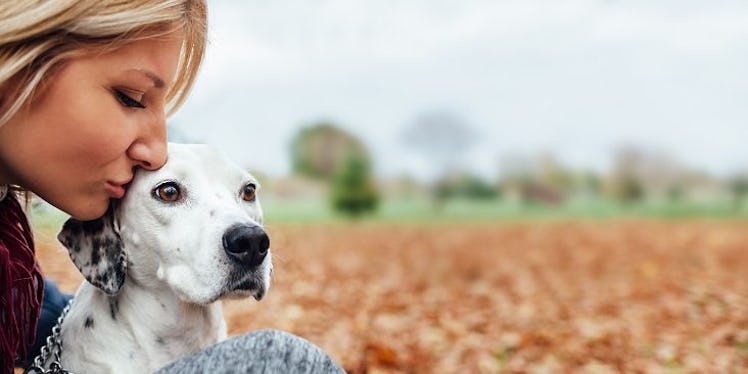
6 Things Every Dog Mom Needs To Know About Translating Puppy Language
Every dog mom only wants the best for their pup, and if they could verbally tell us what works and doesn't work, we'd surely listen. Most of a dog's communication is non-verbal, which means as an owner, you need to be able to take those cues and cater to your pup's needs and wants. There's no harm in learning how to understand your dog better, because ultimately they're loyal as hell animals and we owe it to them to acknowledge their silent language, so to speak.
We've all heard the typical things like looking at wagging tails, etc. but there's so much more than just that. Of course, no two dogs are the same, which is why it's incredibly important not to compare your dog to the next one. Yes, many dogs share the same breed, but they're mannerisms vary depending on what they're feeling and how they react to certain occurrences and situations.
Again, to some of us, our dogs are our babies, and just like a baby can't verbally tell you what's going on with them, your pup is the same way. Tuning in to doggy language is key to better understanding and providing a happy and comfortable life for them. Luckily, Erin Askeland, CPDT-KA and Training and Behavioral Expert at Camp Bow Wow reveals to Elite Daily that there are more than a few indicators that can help dog moms pinpoint what may be going on in your pup's adorable head.
1. Bad Behavior
Our pups have no other consistent obligation other than being our sweet companions. With this in mind, they strive for our attention and sometimes, their attention-getting actions consist of things we do not like. When we get a new puppy, we can't post house rules on the fridge and expect them to read and abide. That's just silly.
We need to react in a way so they understand that what they're doing is not something we want. This can be attained by a little bit of swapping out. Erin Askeland reveals,
For example, if a dog is chewing on a table leg, you can walk them away from the table leg and give them something that you want them to chew on, like a bone or toy.
2. Mastering The Tail Wagging
Surprisingly, a wagging tail does not always translate to a happy pooch. It's similar to how every laugh isn't always genuine or means something is actually funny. There are certain circumstances that regulate our not-so-real chuckles -- admit it.
For pups, Askeland reveals that when your fur baby's tail is tucked and wagging, it could mean they're actually nervous. A stiff and slowly wagging tail indicates that your dog is attentive and alert to their surroundings. When your dog is happy, their "helicopter tail" will be moving in a circle.
3. Deciphering Playtime Antics
You want your dog to play well with others, but you need to know when it's just innocent fun. Because humans don't bark at each other and nip at each other's face when we're having a good time, there's really no way of us knowing that that's normal for our pups. It's important to know that a dog is being aggressive when they clench another dog's muzzle or neck. A crucial note for all of the dog moms out there? Askeland says,
The only time an owner needs to remove their pups from a play situation is if a dog is clearly scared: tail tucked, trying to get away, hide, or appears to be frantic or panicked.
4. Knowing The Difference Between Aggression And Overstimulation
Dogs are known to try and get away from a threatening situation before expressing any aggressive behavior. If they feel cornered and have no way out, growling, showing teeth, and raising their ears and tails so they appear bigger are likely things they'll exude. Don't read too into dilated pupils as something immediately negative. Askeland explains,
Dilated pupils don't necessarily mean “aggression;” it can also mean overstimulation, which is common in puppies, in particular, and often seen before they pounce, even in play.
5. It's All In The Ears
Think of a dog's ear as their antennas that radio to us what their current mood is. Dog ears come in many different shapes and sizes, but can normally point us in the right direction to how our pup's feeling. If your dog's ears are seemingly standing at attention, straight up, they could be curious and/or showing a sign of aggression. If their ears are laying flat against their cute little head, they could be feeling scared or are in a submissive state.
6. Showing Of The Teeth
This concept is actually quite simple. Normally, if your dog is baring teeth, it's deemed as a sign of aggression or they're scared of something. Pups can also expose their teeth when they have their tongues hanging out or are about to get some good licking started. We love our animals because of the devotion and bonds we get to build with them. Getting in tuned with their cues is just another way to show you care and are receptive to their individuality.